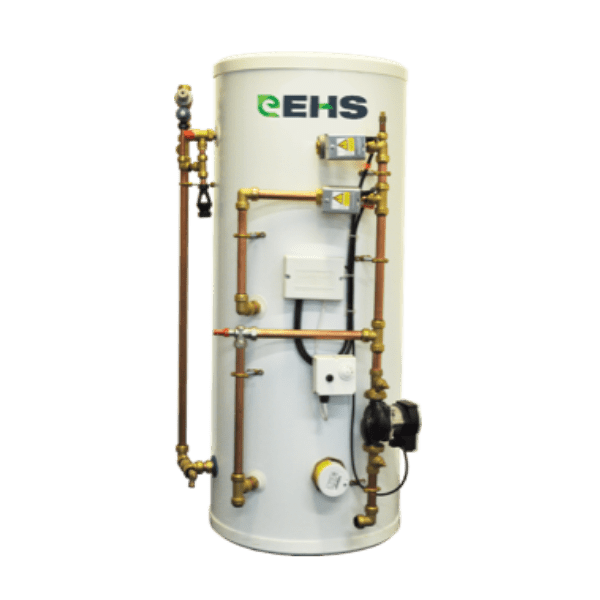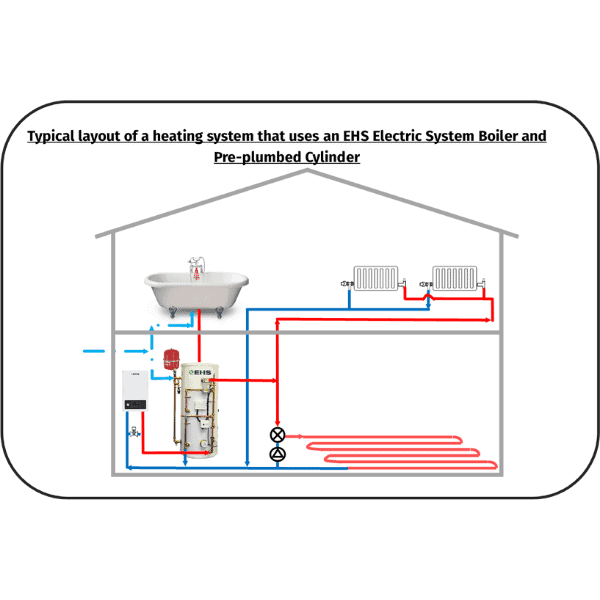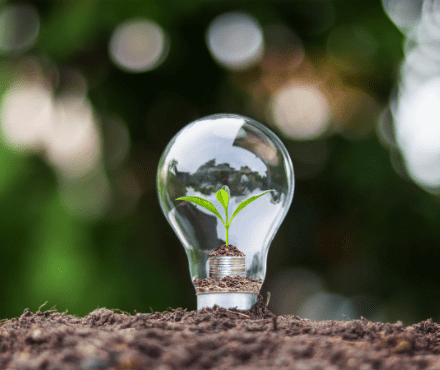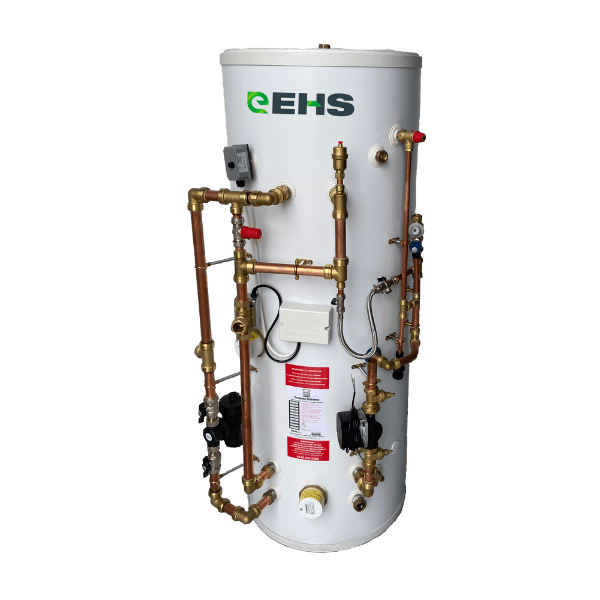- 0345 8628699
- info@ehs-heating.com
- Mon - Fri: 9:00 - 17:00

Hot Water Cylinders
The EHS pre-plumbed indirect hot water storage cylinders feature an internal coil and are designed for use with either our electric system boiler or an air source heat pump as the primary heat source (either sealed system or open vented). Manufactured from Duplex stainless steel, the cylinders are supplied with a factory-fitted 3 kW immersion heater to provide backup heat or to link into a solar PV system. Life-time manufacturing warranty on inner container. 2 years on components.

Hot Water Cylinder Types
There are two types of cylinders.
Vented Hot Water Cylinder
This is the traditional low-pressure system that relies on a header tank (usually in the loft) supplying the cylinder. It used to be the system used in all houses but now is only used in houses with low mains water pressure. The benefit of this system is that the cylinder does not require a yearly check as it is not pressurised. Houses with their feed tank in the loft and bathrooms on the ground floor would benefit from this type of system.
Unvented Hot Water Cylinder
In an unvented system, there is no cold-water tank – instead, a sealed hot water cylinder is fed directly by the cold water mains at mains pressure. An unvented cylinder is kept under this pressure from the incoming main water supply. An unvented system, which is fed directly from the mains into the cylinder, provides large amounts of mains pressure and direct hot water to multiple bathrooms with showers or baths, which is ideal for larger properties. The size or litre capacity of the hot water cylinder you need is dependent on both water demand and the size of your property; for homes with multiple bathroom facilities, a larger cylinder would be most suited.
EHS Hot Water Cylinder Benefits
- Duplex stainless steel provides superior corrosion resistance
- Pre-plumbed with pre-fabricated pipework and wiring
- 316litre grade stainless-steel 22mm compression fittings and coils
- Supplies mains pressure hot water and high flow rates
- Fast reheat
- Factory-fitted temperature and pressure relief valve set at 7 bar / 90°C
- Remote expansion vessel with factory-fitted wall mounting bracket
- Full unvented kit supplied
- Fully insulated to minimise any heat loss
- Available in 90–500 litre capacities
- Lifetime manufacturing warranty on inner container (2 years on components)*
- Renewable and bespoke options available
- Integrates with a Solar PV system

How are hot water cylinders heated?
There there are 2 main ways of heating hot water cylinders.
Direct – Usually, immersion heaters are within the boiler itself. These can be powered by Solar PV, or
Indirect – which is heated by an outside source through a coil. This can be an electric boiler, gas boiler, heat pump, solar thermal, biomass boiler etc
In larger properties with multiple sources of renewable energy, there can be a number of coils and immersion heaters within the cylinder, each taking its energy from a separate source to transfer it to the store.
Most modern cylinders are unvented and will usually have a backup immersion heater. When an electric boiler is controlled to use low-cost energy, it can become more economic than a gas combi boiler for heating hot water. There is a massive range of cylinder types that cater to individual requirements.
What are Unvented Indirect Hot Water Cylinders?
EHS have an extensive range of unvented indirect hot water cylinders that will supply homes with high water use. They feature an internal coil which is designed for use with our EHS air source heat pumps or electric system boiler as the main heat source (either unvented or vented). They require virtually no maintenance and can be coupled with various renewable and low-cost heating technologies.
Manufactured from Duplex stainless steel, the unvented hot water cylinders are also supplied with a factory-fitted 3 kW immersion heater which can be linked into solar PV and also to provide backup heat if there are any issues with the supply of heat from the boiler.
What are Thermal Batteries?
Thermal batteries generally make use of a Phase Change Material (PCM) to store thermal energy. The PCM can store a large amount of energy at a set temperature in a small amount of material, which gives it the advantage of a small drop-off in temperature over a set flow. has an added advantage they work by heating the PCM to a set temperature and then passing mains water through the pipework that flows through the PCM, which gets heated in much the same way as a buffer store
What are the main types of thermal stores?
By far, the most popular and oldest of the thermal stores is a hot water cylinder. You will probably remember when we all had a copper cylinder in the airing cupboard covered with a thermal jacket (before we sold our souls to the gas combi boiler). As the name suggests, this is a store that holds and supplies all of your potable hot water needs within a property. There are hundreds of different types and sizes depending on your energy sources, their capabilities and your daily requirement for hot water.
Hot Water Cylinders and Thermal Energy Storage
Due to the variable nature of renewable energy sources, Energy storage is the key to making the most economic use of self-produced energy (solar thermal/ solar PV or heat pump) or low tariff, renewable electricity. This can be done in a number of ways, but the two most popular in the domestic market are
1) Thermal stores – (Hot water cylinders, Phase change material stores, buffer tanks etc.) and
2) Electric Batteries.
Using thermal stores to save excess production of renewable energy or low-tariff electric energy is the most efficient and economical way to store energy as heat to use when electricity is at a high cost or as a buffer for when your renewable device cannot produce enough energy to supply the whole property with heating and hot water.
A time-of-use tariff for electricity is also key to a low-cost energy system. Low-cost ‘grid’ electricity is generally produced at night when there isn’t much demand for electricity and wind turbines are still producing. By storing this electricity in batteries or as thermal energy in hot water cylinders, you can almost guarantee that it is almost 100% from renewable sources and has the least CO2 of any grid electricity. (The Octopus Go tariff is currently offering 7.5p/kwh between 00:30 am and 4:30 am, which is lower than some Gas prices currently)
If you have Solar PV and/or solar thermal installed at your property, this energy can provide up to and over 70% of your annual hot water for free.
The more cheap renewable energy you can store and use, in either your central heating circuit or for your hot water, the more independent you can be from fossil fuels and grid electricity.
The HWA recently wrote,
“Hot water storage is the only practical solution to turning energy into something useful and banking it for when it needs to be used. The energy storage potential associated with the UK’s installed capacity of domestic hot water cylinders is comparable to our entire fleet of pumped-hydro-electric storage. With just a fraction of this resource, it would be possible to absorb the largest surpluses of renewable power that arise from offshore wind and solar PV.”

